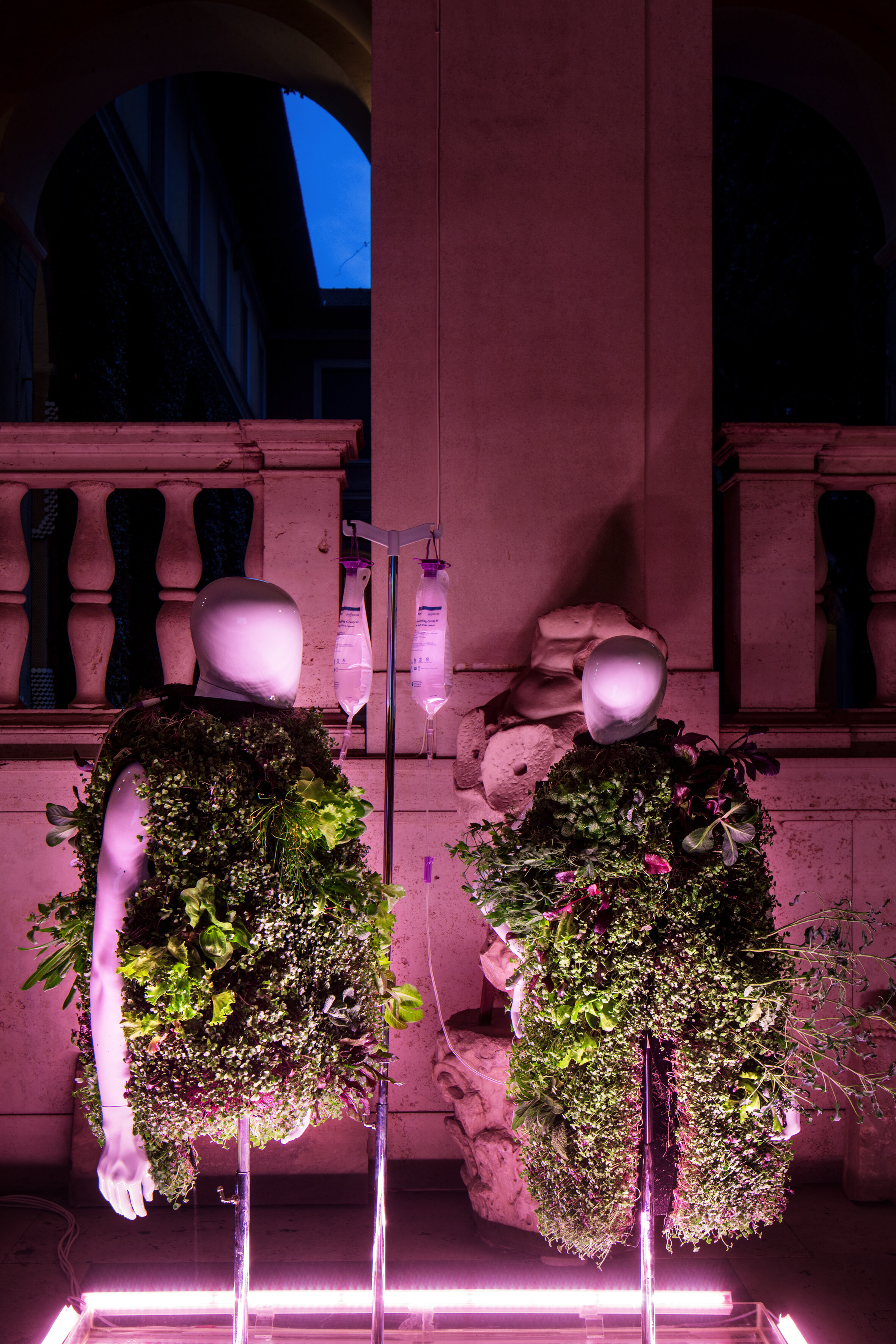Posthuman Habitats - a response to food and water scarcity
Wearing your food - isn’t that the ultimate in self sufficiency? Especially when you fertilise it using your own body’s waste. Landscape architecture professor Aroussiak Gabrielian has created the world’s first wearable, edible vest, which can grow a variety of fresh plants.
The garments promote healthy diets and lifestyle, Gabrielian says, because they are fed by bodily waste, and inspire outdoor exposure to optimise photosynthesis.
Gabrielian’s called her speculative design project Posthuman Habitats, and it’s currently on display in Beijing as part of Human (un)limited, a hybrid art and technology exhibition to showcase forward-thinking works with the aim of enhancing human life.
Known for her work on alternative environmental futures, Gabrielian got the inspiration for the project while pregnant with her daughter.
The vests were exhibited at the American Academy in Rome. Photos by ALTROSAZIO, Roma.
She told business magazine Fast Company that she was amazed at her body’s ability to produce and deliver the exact nutrients her child needed.
As a landscape architect concerned with how to use design to address climate change, she wondered about the possibility of using our bodies to nourish more than just our children.
A co-founder and design director at foreground design agency, and a lecturer at the University of Southern California, Gabrielian’s eco-friendly invention grows seeds embedded in felt vests that retain moisture.
Just one of her prototypes provided nine kilograms of food from 40 different vegetables in just a few weeks, including cabbage, arugula, broccoli rabe, kale, peanuts, peas, mushrooms, strawberries and herbs like sage, rosemary and lemon thyme. But the vest’s primary crop was microgreens which have the added benefit of having 40 times the concentration of nutrients as their fully grown counterparts.
The basic components of the system are the garments themselves which can be stored on mannequins that are attached to IV poles. When not worn, life-support is provided by intravenous irrigation (filtered urine). The cloak is additionally equipped with moisture and nutrient sensors which activate the water pump when needed or if worn, prompt the wearer to go outdoors if more sunlight is required.
Gabrielian says the project responds to the future city’s impending food and water scarcity, dwindling green space in the face of hyper-densification, stresses on energy and water infrastructure, and the nomadic existence that characterises our age of migration.
As a wearable landscape system she says it explores the blurred distinctions between nature-culture, human-machine, and celebrates hybrid ecologies and synthetic forms of nature that are representative of our technologically mediated experience. In particular, it comments on the complete end to romantic notions of “nature” and recognises that even our bodies have become part of this deliberately engineered existence.
The assemblages are not intended to be closed ecosystems but are open to external input and “disturbance,” particularly through pollinators that introduce new species into the garments and create unexpected hybrids. The garments are intended to be optimal habitats for pollinators since these creatures are essential for food production. Cross-pollination sets in motion the hybridization of bodies as well as bodies with the whole environment.
The habitats are essentially cloaks of plant life that are intended to provide sustenance to the wearer, as well as flourish as expanding ecosystems that attract and integrate other animal and insect life, she says.
The recycling of wastes is essential to the perpetuation of the habitats. The plants themselves convert carbon dioxide into sugar and oxygen through the process of photosynthesis. Oxygen can be captured and stored for when air quality diminishes dramatically (see figure 8). Most primarily urine is collected (via catheter), stored, filtered and used to irrigate the plants that provide the base for the system to thrive. Since urine is sterile, low in pathogens and 95% water, it is ideal for irrigation. Using a process of forward osmosis developed by NASA, urine is converted into water (by forcing it through a semi-permeable membrane that filters out the salt, ammonia, etc). Organic matter becomes compost as it is processed by worms and other insects and nourishes plants. Manure of the small animals that occupy the system additionally fertilises the crops. Finally, dead organisms provide food for pollinators and contribute to the humus layer.
“With increased awareness about globalised food industries and their unsustainable carbon footprint, we have become focused on reconnecting the food producer and consumer to develop more self-reliant and resilient food networks,” she says on her website. “Severe drought and diminished soil quality from industrialised farming, as well as sea level rise and climate events will force us to think harder about the future of food production.
“The microhabitats proposed here allow the urban dweller to live off-the-grid, providing immediate access to ‘landscape’ and sources of food.”





